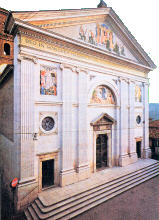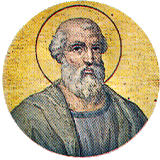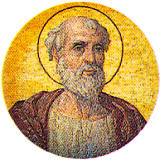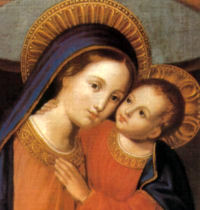Easter: April 26th
Thursday of the Fourth Week of Easter; Optional Memorial of Our Lady of Good Counsel (Can); St. Raphael Arnaiz Baron, monk (Spain
» Enjoy our Liturgical Seasons series of e-books!
Old Calendar: Saints Cletus and Marcellinus, popes and martyrs; Our Lady of Good Counsel
The devotion to our Lady of Good Counsel originated at Gennazzano, a village in the neighborhood of Rome, where an Augustinian church, in which is enshrined a miraculous picture of our Lady, had been for centuries a place of popular pilgrimage. This feast is observed in Canada.
According to the 1962 Missal of Bl. John XXIII the Extraordinary Form of the Roman Rite, today is the feast of Sts. Cletus and Marcellinus. St. Cletus, who is probably identical with St. Anacletus (his feast moved from July 13 before 1961), figures in the list of Popes as the second successor of St. Peter, A.D. 76-88. St. Marcellinus governed the Church two centuries later, from A.D. 296 to 304, during the terrible Diocletian persecution.
The Church in Spain celebrates the feast of St. Rafael Arnáiz, who was born in Burgos, Spain on twentieth century.
Our Lady of Good Counsel On the Feast of Saint Mark, April 25 1467, the people of Genazzano, Italy witnessed a marvellous sight. A cloud descended upon an ancient church dedicated to Our Lady of Good Counsel. When the cloud disappeared, an image of Our Lady and the Child Jesus was revealed which had not been there before. The image, on a paper-thin sheet, was suspended miraculously.
On the Feast of Saint Mark, April 25 1467, the people of Genazzano, Italy witnessed a marvellous sight. A cloud descended upon an ancient church dedicated to Our Lady of Good Counsel. When the cloud disappeared, an image of Our Lady and the Child Jesus was revealed which had not been there before. The image, on a paper-thin sheet, was suspended miraculously.
Soon after the image's appearance many miracles were attributed to the intercession of Our Lady of Good Counsel. Because of this, Pope Paul II ordered an investigation and the results have been preserved.
It was later discovered that the very same image had been seen in a church dedicated to the Annunciation in Scutari, Albania. The image in this church was said to have arrived there in a miraculous manner. Now, the image had been transported from Albania miraculously to avoid sacrilege from Moslem invasion.
A commission of enquiry determined that a portrait from the church was indeed missing. An empty space the same size as the portrait was displayed for all to see.
Many miracles continue to be attributed to Our Lady of Good Counsel. Pope Saint Pius V, for example, credited victory in the Battle of Lepanto to Her intercession.
Several Popes have approved the miraculous image. In 1682 Pope Innocent XI had the portrait crowned with gold. On July 2 1753 Pope Benedict XIV approved the Scapular of Our Lady of Good Counsel, and was the first to wear it.
In 1884 a special Mass and Office of the Feast of Our Lady of Good Counsel was approved by Pope Leo XIII.
For more than 500 years the image has continued to attract countless pilgrims.
Although much of the church was destroyed during World War II, the image has remained intact — and continues to be suspended miraculously.
Patron: Albania, enlightenment.
St. Cletus I Emperor Vespasian reigned in Rome when Cletus assumed leadership of the Church. His specific responsibilities, like those of his predecessor Linus, can only be surmised because a monarchial episcopate had not yet emerged in Rome. Little is known of Cletus, perhaps due to the confusion over his name. Some historians refer to him as Anacletus or, more correctly, Anencletus, which is a Greek adjective meaning "blameless." There is, however, no doubt that he is recognized as the third successor and is commemorated in the ancient canon of the Mass.
Emperor Vespasian reigned in Rome when Cletus assumed leadership of the Church. His specific responsibilities, like those of his predecessor Linus, can only be surmised because a monarchial episcopate had not yet emerged in Rome. Little is known of Cletus, perhaps due to the confusion over his name. Some historians refer to him as Anacletus or, more correctly, Anencletus, which is a Greek adjective meaning "blameless." There is, however, no doubt that he is recognized as the third successor and is commemorated in the ancient canon of the Mass.
According to tradition, he appointed twenty-five presbyters for Rome and erected a shrine over the burial place of Peter. He is said to have died a martyr, in the twelfth year of the reign of Emperor Domitian, and was buried on the Vatican Hill.
Excerpted from The Popes: A Papal History, J.V. Bartlett
St. Marcellinus St. Marcellinus was Pope during the Diocletian persecution (296-304). With wise forethought he ordered large rooms to be constructed in the catacombs for liturgical use. Such a chamber in the catacomb of Callistus still recalls his action. According to one ancient account (certainly erroneous), this pope strewed incense before the gods when arrested during the persecution, but later atoned for his weakness by a glorious martyrdom. His grave in the catacomb of Priscilla was an object of highest honor.
St. Marcellinus was Pope during the Diocletian persecution (296-304). With wise forethought he ordered large rooms to be constructed in the catacombs for liturgical use. Such a chamber in the catacomb of Callistus still recalls his action. According to one ancient account (certainly erroneous), this pope strewed incense before the gods when arrested during the persecution, but later atoned for his weakness by a glorious martyrdom. His grave in the catacomb of Priscilla was an object of highest honor.
Excerpted from The Church's Year of Grace, Pius Parsch
St. Raphael Arnaiz Baron Raphael Arnáiz Barón was born in Burgos (Spain) April 9, 1911, into a prominent, deeply Christian family. He was baptised and confirmed in Burgos and began his schooling at the Jesuit college in the same city where, in 1919, he was admitted to first Communion.
Raphael Arnáiz Barón was born in Burgos (Spain) April 9, 1911, into a prominent, deeply Christian family. He was baptised and confirmed in Burgos and began his schooling at the Jesuit college in the same city where, in 1919, he was admitted to first Communion.
It was at this time that he had his first experience of illness: persistent fevers due to colibacillosis forced him to interrupt his studies. To mark his recovery, which he attributed to a special intervention of the Virgin Mary, his father took him to Zaragoza and consecrated him to the Virgin of Pilar. This experience, which took place in the late summer of 1921, profoundly marked Raphael.
When the family moved to Oviedo, he continued his secondary schooling with the Jesuits there, obtaining a diploma in science. He then enrolled in the School of Architecture in Madrid, where he succeeded in balancing his studies with a life of fervent piety.
Possessing a brilliant and eclectic mind, Raphael also stood out because of his deep sense of friendship and his fine features. Blessed with a happy and jovial nature he was also athletic, had a gift for drawing and painting as well a love for music and the theatre. But as he matured, his spiritual experience of the Christian life deepened.
Although the study of architecture required a great deal of hard work and discipline, at that time he began the practice of making a long daily visit to the Blessed Sacrament in the Chapel of "Caballero de Gracia". He even joined the Nocturnal Adoration Association, and faithfully took his turn before the Blessed Sacrament.
In this way his heart became well disposed to listening, and he perceived an invitation from God to lead the contemplative life.
Raphael had already been in contact with the Trappist monastery of San Isidro de Dueñas, and he felt strongly drawn to this place, responding to his deepest desires. In December of 1933 he suddenly broke off his professional studies and on January 16, 1934 entered the monastery of San Isidro.
After the first months of the noviciate and his first Lent, which he lived with great enthusiasm, embracing all the austerities of Trappist life, God mysteriously chose to test him with a sudden and painful infirmity: a serious form of diabetes mellitus which forced him to leave the monastery immediately and return to his family in order to receive the proper care.
Barely recovered, he returned to the monastery, but his illness forced him to leave the monastery for treatment again and again. But whenever he was absent he wanted to return, responding faithfully and generously to what he understood to be a call from God.
Sanctified by his joyful and heroic fidelity to his vocation, in his loving acceptance of the Divine will and the mystery of the Cross, in his impassioned search for the Face of God, fascinated by his contemplation of the Absolute, in his tender and filial devotion to the Virgin Mary-"the Lady", as he liked to call her-his life came to an end on April 26, 1938. He was barely 27 years old. He was buried in the monastery cemetery, and later in the Abbey church.
The fame of his sanctity rapidly spread beyond the walls of the monastery. The example of his life together with his many spiritual writings continue to spread and greatly profit those who get to know him. He has been described as one of the great mystics of the twentieth century.
On August 19, 1989, the Holy Father John Paul II, on World Youth Day at Santiago de Compostella, proposed him as a model for young people today, and beatified him on September 27, 1992.
Pope Benedict XVI canonized him on October 11, 2009 and presented him as a friend and intercessor for all the faithful, especially for the young.
Copyright © Libreria Editrice Vaticana
